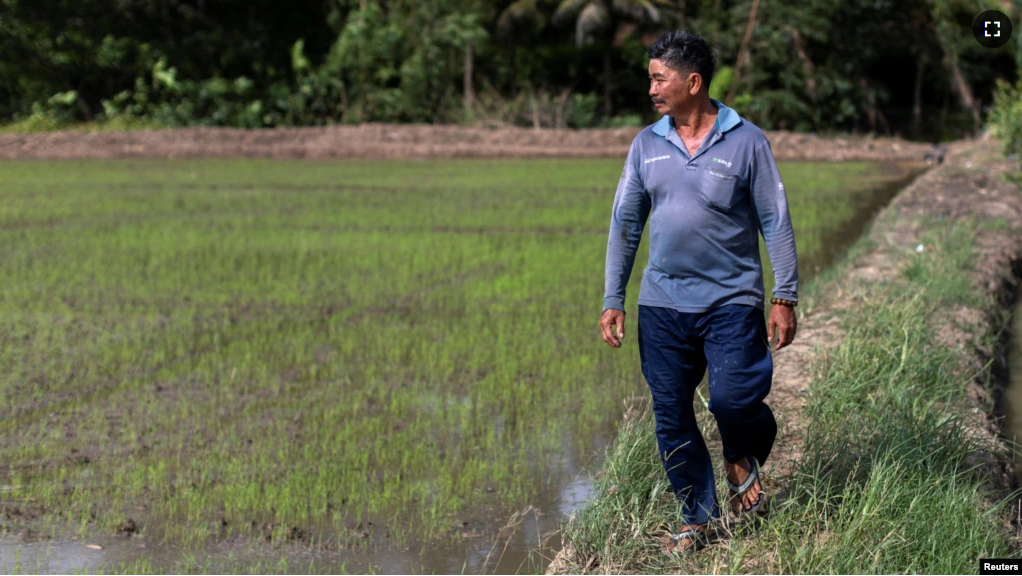Standing on his land next to the Mekong River, Tran Van Cung of Vietnam can see his rice farm wash away right in front of him.
The farm’s edge is falling into the river delta.
Just 15 years ago, the river carried 143 million metric tons of sediment through the Mekong River Delta every year. The process carried essential nutrients along the river’s edge that helped keep tens of thousands of farms productive.
But Chinese-built hydroelectric dams have caused the river to spread out. Much of that sediment is now being blocked. That information is based on a study of satellite imagery by the German remote sensing company EOMAP and the news agency Reuters.
The study supports earlier estimates by the Mekong River Commission that, in 2020, only about one-third of those river soils would reach the floodplains in Vietnam.
The commission also estimated that less than five million metric tonnes of sediment will be reaching the delta each year by 2040.
The Mekong River is a farming and fishing lifeline for tens of millions of people. The river stretches nearly 5,000 kilometers. It flows through China, Laos, Myanmar, Thailand and Cambodia before reaching Vietnam.
Cung, the Vietnamese farmer, has grown rice at his family’s 10-hectare farm for more than 40 years.
“Without sediment, we are done,” he said. His yearly harvest brings in less than half the money that he earned only a few years ago. His two children and several of his neighbors have left the area in search of more dependable work.
Dams trap sediment
For many years, scientists and others have warned that upstream dam projects would have serious and harmful effects on the rice-growing industry. The area’s rice market is worth $10.5 billion. Rice is a major source of food for up to 200 million people across Asia.
Because of these worries, Cambodia has temporarily halted its plans for building two dams on the river.
But in China and Laos, the dam-building continues. Seven new dams are planned in Laos. At least four are co-financed by Chinese companies, the Mekong Dam Monitor says.
Using data from thousands of satellite images, EOMAP and Reuters examined sediment levels around four major dams on the Mekong – two in China and two in Laos.
The analysis showed the presence of each dam greatly reduced the sediment that should have flowed through the river.
Farmers in the Vietnamese Mekong River Delta were not prepared for the speed at which their land has changed.
The area where rice farming takes place has shrunk by five percent in the last five years alone. Many rice farmers have been forced to do shrimp farming in salty seawater instead. Yearly earnings in this once-booming area are now among Vietnam’s lowest.
Far-reaching effects
EOMAP and Reuters studied satellite images taken over 30 years around four major dams in China and Laos. The examination found evidence that the dams are greatly reducing sediment flow.
The study used measurements of the amount of light scattered by solid particles suspended in water as a way to estimate sediment levels. Sediment clouds the water as it flows. The cloudier the water, the more sediment it is likely carrying.
Scientists not involved in the examination agreed that the findings made clear that the dams were a major reason for the delta’s sediment loss.
“Mainstream dams catch everything,” said economist Brian Eyler at the Stimson Center, which runs the Mekong Dam Monitor. “China’s got 11 on the mainstream, plus other countries, so all these are working together to reduce sediment load,” Eyler added.
The Xayaburi and Don Sahong dams in Laos are the most recent to begin operating. The Xayaburi is now the largest dam on the Mekong River. Both structures faced years of opposition from environmental activists.
Reuters asked both the Chinese and Laotian governments about the effects of their dams and their plans for building more. China’s foreign ministry did not answer questions about its existing and planned dams or their effects on sediment levels. The Laotian government did not answer requests for comment.
Downriver countries affected by the sediment loss have urged China to share its data on sediment flows. China shares data only about the water levels and flow rates from its mainstream dams.
Last year, the Mekong River Commission launched its own joint study with China looking at the dams’ impacts on the whole river basin. The results will not be known until 2024 at the earliest.
Sitting by the river, the rice farmer Cung said he and other area farmers have struggled to find information about how to deal with the changes caused by dams. The situation has led many to leave farming and the area.
“It’s not an easy decision to make,” Cung said. “But sometimes quitting is the only economic choice that makes sense.”
I’m Ashley Thompson.
I’m John Russell.
Reuters reported this story. Ashley Thompson adapted it for VOA Learning English. __________________________________________________
Words in This Story
delta – n. the triangular or fan-shaped piece of land made by deposits of mud and sand at the mouth of a river
sediment – n. the matter that settles to the bottom of a liquid
analysis – n. an examination of a whole to discover its elements and their relations
scatter – v. to separate and go in different directions
impact – n. a forceful effect
quit – v. to stop or end (as an action or activity) permanently
